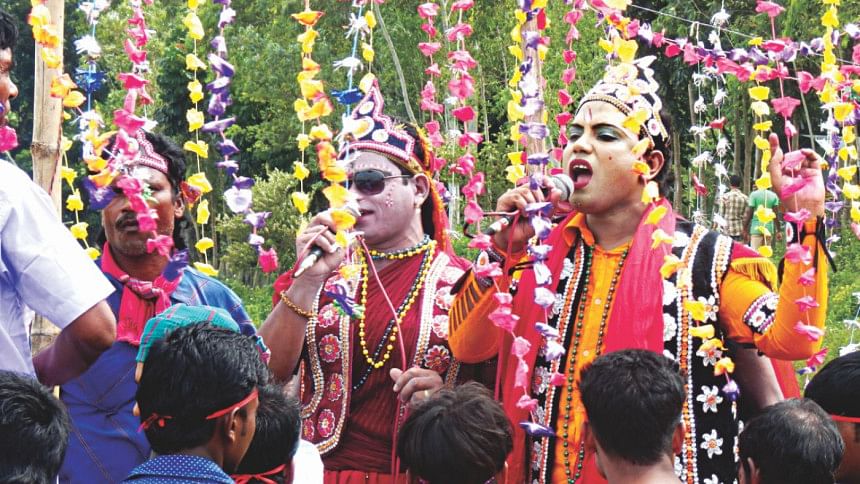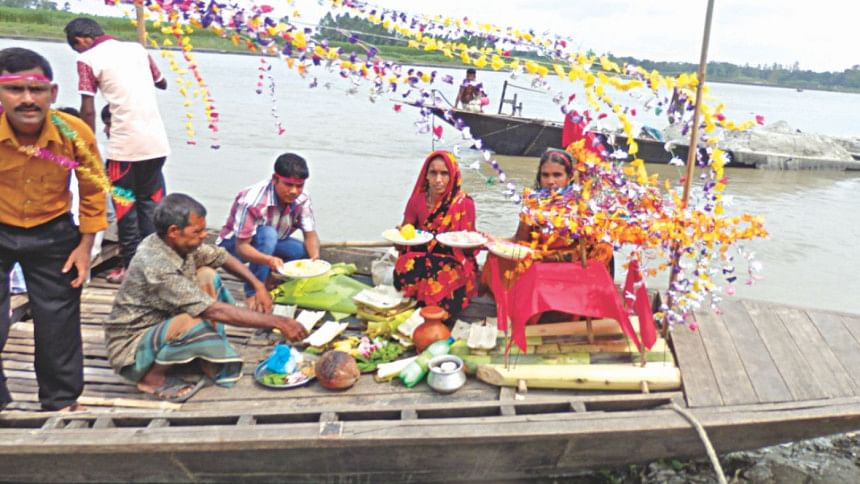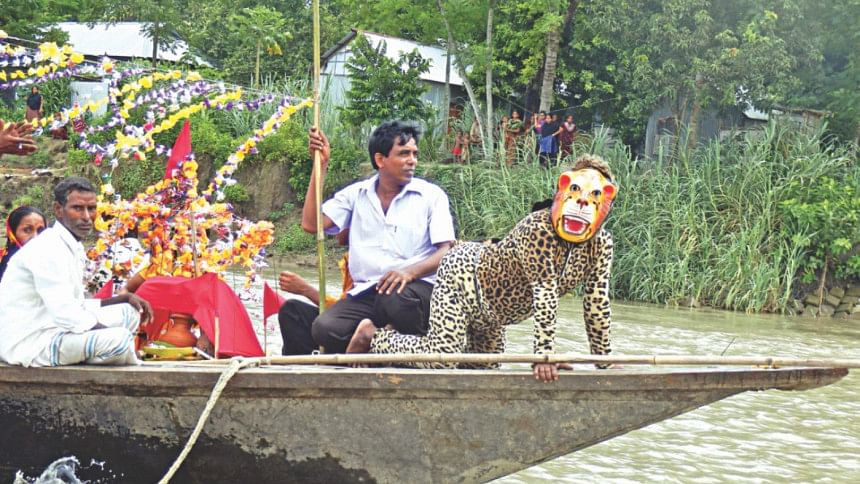Of Monsoons, Myths and Manasa

In Bangladesh, after the scorching heat of 'grishsho', or summer, comes the monsoons and with it come welcome thunder, lightning and pouring rainfall. But, in rural areas, with the downpour, comes the menace of snakes that spread a pall of fear. Thus, all over the countryside, amongst the marginalized communities, be they Muslim or Hindu, householders organize performative rituals to appease the mighty Goddess of Serpents, Manasa Devi. As the legend goes, she is the mind-born daughter of Shiva, whom the hapless Brahmin merchant Chand Saudagar refused to worship. Manasa retaliated by taking the life of Chand's youngest son Lokkhindor. Thus began the epic battle between Lokkhindor's newlywed bride Behula, and the mighty Serpent Goddess. Behula resolutely carried her dead husband's body on a raft over the river to the great God Shiva, overcoming obstacles at seven 'ghats' or wharfs to finally compel Manasa to give back Lokkhindor's life.
Amazingly, this tale is performed every year, on the rivers of Tangail, on 'Srabon Shongkranti', the last day of the month of Srabon, as a riverine performance on colorfully bedecked boats. Nothing could be more Bangladeshi than this exciting day-long performance, with actors dressed as Behula, Lokkhindor and other characters of this tale of Manasa. Competing groups take out colorfully decorated boats, stopping at seven 'ghats', emulating Behula's journey, till each stops at a designated household where the 'jiyoni', or 'bringing back from dead' last act, is performed to bring the hapless Lokkhindor back to life.

Known as 'Shone Dala', the 'Offering of Srabon', these performances are in fact efficacious 'ritual' performed against a 'manot' or pledge, by a householder to appease Manasa in the hope of getting a boon from her, in the form of 'good health' for the household, or to overcome other such minor householder's obstacles. The performers, though popular village bards and actors, are all, additionally faith-healers, or 'ojhas' revered for their capacity to cure minor diseases with their wealth of knowledge about herbs and natural cure. Each performance is begun with the 'ojha' offering worship to Manasa, and with pronouncements of 'mantras'.
Surprisingly, all the actors of this event - the 'ojha', the householder, the afflicted and the onlookers, are all Muslims, standing testimony to the assimilative and plural practices of rural Bangladesh, especially amongst the marginalized.

The tradition of this assimilative tradition goes far back into history. Manasa is basically the primordial, definitely pre-Aryan female fertility goddess, whom the Brahmins refused to acknowledge. That she has survived, not just the Aryan onslaught, but also that of Buddhism, Islam and Christianity and continues to be revered, is testimony to the power of this rustic female deity. Not surprisingly, the worship of Manasa is a cross-border cultural practice shared by Bangladesh, India and Nepal, going to further elaborate the power of this Goddess.
Practiced in various regions, the 'myth of Manasa' is celebrated through the chanting of rhymes, panchalis (a long narrative celebrating the glory of a deity) and vratakatha (rhymes and narratives chanted on the occasion of the performance of a vow). By the fifteenth century, all these oral practices had crystallised into the genre of the Mangal Kavya. In various regions of Bangladesh, the 'myth of Manasa' is performed under different names: 'Poddor Nachon' in Kushtia, and Pabna; 'Behular Lachari' in Tangail and Ghatail, 'Behular Bhashan' in Mymensingh et al. Each has its own genre of performance. In West Bengal it is celebrated as 'Jhapan', while in Assam as 'Ojha-pali'.

The long history of its practice and the historical reason for Manasa's worship within Muslims has been well documented and explained. In 1917 Rai Saheb Dineshchandra Sen writes, 'The Muhammadans are now mostly the 'rojahs' or physicians of serpent bites in Bengal. They recite incantations and 'mantras' for the cure of not only those who are bitten by serpents but also of those said to be possessed by spirits. From generation to generation, these 'rojhas', mostly Muhammadans, as I have said, have been practitioners of this art. They no doubt sprang from the Hindu and Buddhist families and did not, after they were converted to Muhammadan faith, give up a calling which had been a source of their maintenance from remote times'.
It is cultural practices like these that define the plural nature of Bangladesh. And, it is this plurality of beliefs that makes us a tolerant and liberal nation. It is time to recognize these practices and strengthen them.
The author is a Dancer, Cultural Activist and Researcher

 For all latest news, follow The Daily Star's Google News channel.
For all latest news, follow The Daily Star's Google News channel. 



Comments